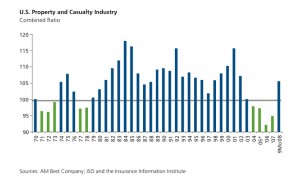In a previous entry, I wrote about anticipated increases in property-casualty insurance premiums. Reinsurance broker Guy Carpenter, published a report Cats and Credit Push Prices Up: Global Reinsurance Review January 2009 in which it found that property casualty rates rose only 11% across the United States this year. You may wince at the word “only”, but this rate increase is dampened as compared with what followed Hurricane Andrew in 1992, the terrorist attacks of September 11, 2001, and Hurricanes Katrina, Rita and Wilma in 2005. This is remarkable given the level of catastrophes (close to $20 billion in insured losses) in 2008 and the financial losses on the investment portfolios of insurance companies. The rate hikes could have been much, much worse. What typically happens after two or three annual renewal seasons of increasing rates is that the Fortune 500 will seek alternative means of financing their risks at lower costs. This might include self-insurance through corporate captives, for examples. Four states – Michigan, Missouri, Louisiana and Connecticut – are enacting legislation similar to the statutes in Vermont to establish captive insurance companies in their jurisdictions or to persuade existing captives to re-domicile. The recent announcement of President Obama concerning increasing scrutiny of offshore corporate vehicles (corporate captives are commonly found in places like Bermuda and the Cayman Islands) may accelerate this trend. What this means is that supply and demand will eventually favor the small businesses. As large corporate insureds withdraw from the expensive primary insurance market in favor of less expensive alternative risk financing vehicles, demand declines and price follows. Small businesses can then purchase their insurance at lower costs. In other words, sit tight, Fortune 500 companies will soon look to cut their insurance expenses and we will benefit from the lower prices that follow their actions.
Posts Tagged ‘Insurance Premiums’
Sit Tight and Follow the Fortune 500
Friday, May 8th, 2009Cash Flow Underwriting
Monday, May 4th, 2009In Prepare for the Worst, Plan for the Best: Disaster Preparedness and Recovery for Small Businesses (John Wiley & Sons Inc., second edition, 2008), I explained the cash flow of an insurance company (page 178):
“An insurance company collects premiums from its policyholders. such as your small business. It invests these premiums in assets, such as high-quality bonds and blue chip stocks, to earn investment income. It pays out expenses, such as premiums for its own reinsurance coverage, salaries to employees and so forth. It also pays claims to its policyholders for insured losses, or damages. The cash flow of an insurance company (premiums plus investment income less expenses less losses) is often expressed in terms of a combined ratio. The combined ratio is the sum of the loss ratio plus the expense ratio. A loss ratio of 100%, for example, means that for every dollar the insurance company collected in premiums, it paid out one dollar in losses and expenses. An insurance company with such a loss experience stays in business by engaging in so-called cash flow underwriting; that is, its insurance losses are more than offset by the investment income the insurance company earns on its premiums. In 1999, for example, insurance companies were paying out $1.07 in claims and expenses for every dollar collected in premiums. You can appreciate how sensitive the insurance industry is to the financial markets.”
When the combined ratio becomes unsustainably high, the insurance industry can no longer rely on cash flow underwriting and has to raise premiums. Insurance industry professionals refer to this as a “hard market”, one in which rates are rising. This graph here shows the combined ratio for the U.S. property-casualty insurance industry from 1970 through the third quarter of 2008. The horizontal grey line shows the combined ratio at 100%, that is when the insurance industry breaks even. The bars that extend above the grey line are shaded in blue and show when the insurance industry is underwriting risks at a loss and relying on investment income to remain profitable. The green bars are those that do not reach the grey line; that is, the combined ratios are below 100% and the industry is making underwriting profits.
The insurance industry had a particularly difficult year in 2008: for the first three quarters of last year, the U.S. property-casualty industry paid $19.9 billion for catastrophic losses. These losses occurred at a time when the financial markets were in decline, and so investment income was insufficient to compensate for underwriting losses. Hence, the bar for the first three quarters of 2008 is blue in color, extending above the grey line for a 100% combined ratio. This suggests that the insurance market is about to become “hard”, cash flow underwriting is about to end, and premiums will rise. Better to renew your insurance coverage sooner rather than later, as later it will likely be more expensive.

